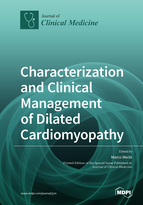Characterization and Clinical Management of Dilated Cardiomyopathy
A special issue of Journal of Clinical Medicine (ISSN 2077-0383). This special issue belongs to the section "Cardiology".
Deadline for manuscript submissions: closed (31 July 2020) | Viewed by 62441
Special Issue Editor
Interests: heart failure; dilated cardiomyopathy; myocarditis; genetics; non-ischemic cardiomyopathy; cardiac magnetic resonance; long term survival; arrhythmic risk stratification; left ventricular reverse remodeling
Special Issue Information
Dear Colleagues,
Dilated cardiomyopathy (DCM) is a particular phenotype of non-ischemic systolic heart failure, frequently recognizing a genetic background and affecting relatively young patients with few comorbidities. Nowadays, long-term survival of DCM patients has been markedly improved due to an early diagnosis, and the uninterrupted and tailored follow-up under constant optimal medical and non-pharmacological evidence-based treatments. Nevertheless, DCM is still one of the most common causes of heart transplantation in the Western World. Clinical management requires an integrated and systematic use of diagnostic tools and a deeper investigation of the basic mechanisms underlying the disease. However, several emerging issues remain still debated. Specifically, the genotype-phenotype correlation, the role of advanced imaging techniques and genetic testing, the lack of appropriate risk stratification models, the need of multiparametric and multidisciplinary approach for device implantation, and a continuous reclassification of the disease during follow-up remain challenging issues in clinical practice.
Therefore, the aim of this special issue is to shed the light on the most recent advancements in characterization and clinical management of DCM, in order to unveil the conundrum of this particular disease.
Prof. Dr. Marco Merlo
Guest Editor
Manuscript Submission Information
Manuscripts should be submitted online at www.mdpi.com by registering and logging in to this website. Once you are registered, click here to go to the submission form. Manuscripts can be submitted until the deadline. All submissions that pass pre-check are peer-reviewed. Accepted papers will be published continuously in the journal (as soon as accepted) and will be listed together on the special issue website. Research articles, review articles as well as short communications are invited. For planned papers, a title and short abstract (about 100 words) can be sent to the Editorial Office for announcement on this website.
Submitted manuscripts should not have been published previously, nor be under consideration for publication elsewhere (except conference proceedings papers). All manuscripts are thoroughly refereed through a single-blind peer-review process. A guide for authors and other relevant information for submission of manuscripts is available on the Instructions for Authors page. Journal of Clinical Medicine is an international peer-reviewed open access semimonthly journal published by MDPI.
Please visit the Instructions for Authors page before submitting a manuscript. The Article Processing Charge (APC) for publication in this open access journal is 2600 CHF (Swiss Francs). Submitted papers should be well formatted and use good English. Authors may use MDPI's English editing service prior to publication or during author revisions.
Keywords
- dilated cardiomyopathy
- non-ischemic cardiomyopathy
- heart failure with reduced ejection fraction
- genetics
- cardiac magnetic resonance
- long term survival
- arrhythmic risk stratification







